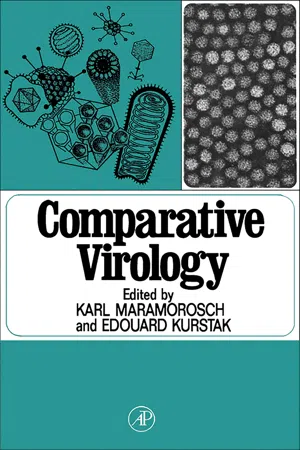
- 600 pages
- English
- ePUB (mobile friendly)
- Available on iOS & Android
Comparative Virology
About This Book
Comparative Virology provides an integrated comparison of viruses, based on their chemical and morphological characteristics. These descriptions will not only give the reader a background but also a detailed analysis of the various groups. In some instances the groups are still host related, as in the case of bacteriophages and polyhedral insect viruses. In others, for instance in pox viruses, the group comprises viruses of vertebrates and invertebrates. The hosts of the bacilliform Rhabdovirales range from man and other warm-blooded vertebrates through invertebrate animals to plants. A special chapter is devoted to viruses devoid of protein—a group that is of great interest and that has only recently been recognized. Since there is historical and practical interest in écologie groupings, such as arboviruses and oncogenic viruses, chapters on such groups have also been included. The book opens with a discussion on the classification of viruses. Chapters dealing with DNA viruses and RNA viruses follow, and the ecologically and disease-oriented groups complete the volume. It is hoped that ""Comparative Virology"" will help bring unity to the science of virology through the comparative approach that is not dependent on virus-host interactions. The combined efforts of eminent contributors to discuss and evaluate new information will hopefully benefit all who are interested in virology
Frequently asked questions
Information
Remarks on the Classification of Viruses
Publisher Summary
I Introduction
Table of contents
- Cover image
- Title page
- Table of Contents
- CONTRIBUTORS
- Copyright
- List of Contributors
- Preface
- Chapter 1: Remarks on the Classification of Viruses
- Chapter 2: Small DNA Viruses
- Chapter 3: The Papovavirus Group
- Chapter 4: Adenoviruses
- Chapter 5: Herpesviruses: Current Information on the Composition and Structure
- Chapter 6: Comparative Observations on Poxviruses of Invertebrates and Vertebrates
- Chapter 7: A Comparative Study of the Structure and Biological Properties of Bacteriophages
- Chapter 8: Picornaviral Architecture
- Chapter 9: Arboviruses: Incorporation in a General System of Virus Classification
- Chapter 10: Comparative Properties of Rod-Shaped Viruses
- Chapter 11: Bullet-Shaped Viruses
- Chapter 12: Structure and Transcription of the Genomes of Double-Stranded RNA Viruses
- Chapter 13: The Structure and Assembly of Influenza and Parainfluenza Viruses
- Chapter 14: A Plant Virus with Properties of a Free Ribonucleic Acid: Potato Spindle Tuber Virus
- Chapter 15: The Viruses Causing the Polyhedroses and Granuloses of Insects
- Chapter 16: Oncogenic Viruses: A Survey of Their Properties
- Author Index
- Subject Index